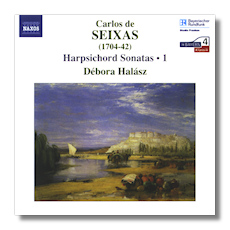
The Internet's Premier Classical Music Source
Related Links
- Seixas Reviews
- Latest Reviews
- More Reviews
-
By Composer
-
Collections
DVD & Blu-ray
Books
Concert Reviews
Articles/Interviews
Software
Audio
Search Amazon
Recommended Links
Site News
 CD Review
CD Review
Carlos de Seixas

Portugal's Late Baroque Genius
- Sonata #10 in C Major
- Sonata #18 in C minor
- Sonata #19 in D Major
- Sonata #24 in D minor
- Sonata #27 in D minor
- Sonata #34 in E Major
- Sonata #36 in E minor
- Sonata #37 in E minor
- Sonata #42 in F minor
- Sonata #43 in F minor
- Sonata #44 in F minor
- Sonata #50 in G minor
- Sonata #57 in A minor
Débora Halász, harpsichord
Naxos 8.557459 70:36
Until recently, a search for keyboard music by Portugal's Carlos de Seixas (1704-1742) would turn up next to nothing: a couple of deleted items and maybe a few sonatas in anthologies featuring others by Scarlatti or perhaps Antonio Soler. A sense of his music would be hard to gather up, and it would require some expense.
This CD changes all that. It also makes one wish that some Lisbon dig would unearth more of the nearly 700 Seixas pieces for harpsichord that were supposedly lost during Lisbon's great 1755 earthquake, a few years after his death, especially if some of it matched the level of these sonatas. Naxos reports plans to release those that have survived: the liner notes mention a collection of eighty – thirteen of which appear here, played very ably by Brazilian virtuoso Débora Halász. At least five more Seixas CDs should gradually be released, which is good news indeed for baroque music fans.
Seixas was the cathedral organist at his native Coimbra from the age of fourteen, but at sixteen he was appointed Vice Master organist in Lisbon's Royal Chapel – the Chapel Master being none other than Domenico Scarlatti. During Scarlatti's five years in Portugal, he taught and was said to admire young Carlos, who eventually replaced him as Chapel Master and harpsichord teacher at Lisbon's royal court. A Portuguese dictionary from 1760 reports that, upon first witnessing Seixas" playing, Scarlatti said to the youth that he ought to teach him, Scarlatti, rather than the other way around, as the Portuguese monarch had commanded the Italian master. Seixas died early, at 38, but was already regarded as the highest-ranking Portuguese musician of his time. Some mutual influence in their keyboard music seems likely, although the sonata form was developed further by the longer-lived Scarlatti.
Seixas" works often feature a relatively simple left-hand part while the melodic structures for the right hand are elaborated and developed through variations. Most sonatas on this disc are in two movements, some are in three, and a few are in a single movement; a one- to three-minute duration is typical, two movements last less than a minute, and just one is 13 minutes long.
The soloist displays the harpsichord's expressive variety, as well as her own considerable talents, through a mix that, for instance, has a graceful piece requiring a toy piano-like sound, such as the Sonata 24's closing movement, followed immediately, and every bit as adroitly, with something calling for an aggressive clangour – in this case, the intricate and challenging 27th Sonata. The differentiation in tempo, touch and articulation of Seixas" music make for a remarkably wide expressive range that can comprise the poignant Largo to Sonata #18, which is full of sadness or a mature resignation, and the exuberant Allegro that follows, which is suggestive of the most youthful restlessness. This range includes the 24th Sonata's heaven-storming opening, the brash, heroic tonalities of Nos 19 and 44, graceful sweetness in Sonata 37, and wistful lyricism in the Moderato of Sonata 43. This last piece inhabits a sound-world akin to Antonio Soler's sublime Fandango, although it is clearly nowhere as lengthy nor weighty in intent. Also worth noting is the engaging and ambitious Sonata #57, for its harmonically-rich and grandiloquent opening movement, followed by a delicate, contemplative middle, and closing with a fast movement of unexpected extroversion.
It may be something of a fool's errand to try to sit through 71 minutes of any solo instrument that is not "live," no matter how delightful each piece; this certainly applies to baroque harpsichord music – unless one is a die-hard keyboard head-banger or in a very special mood. Still, the three recent Naxos releases of Buxtehude's trio sonatas show how enjoyable well-played baroque chamber recitals in historically-informed performances can be, and that they amply reward repeated listening. Naxos has also been gradually releasing Scarlatti's keyboard sonatas in piano versions that feature a different artist per CD: this will be the first complete traversal since Scott Ross" survey for Erato, and has already yielded several successes.
With this release Naxos has clearly issued the best single CD to gain the acquaintance of Portugal's underappreciated late baroque musical genius.
So bravo yet again!
Post script: After noticing that this recording came out three years ago without trace of the promised volumes to come, I posted a query on the Naxos site and even reached Klaus Heymann on the subject. After a few months, no reply has yet to reach me from either source, although Heymann has e-mailed me in the past (to say, on one occasion, that his vaults hold an unissued recording of Frank Martin's delightful Harpsichord Concerto of 1951-52). Further sales of this first volume may yet prompt them to continue the series – unless perhaps there was some dispute with the artist, or with Bavarian Radio? Still, I'll be keeping out a hopeful eye for some future Seixas releases by the label.
Copyright © 2009, Bert Bailey




















